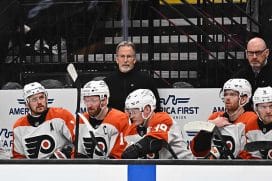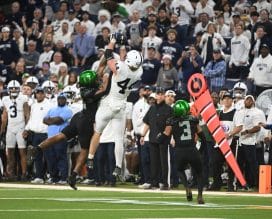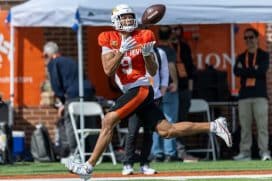Flyers
Around the NHL: GM Axing, All-Star Action, and Player Tracking
By Ryan Black, Sports Talk Philly staff writer
After eight days off, Philadelphia Flyers hockey finally resumed on Monday night. As you warm up for three more games on the schedule this week, let’s take a look back at recent news from around the league, including the shakeup in Edmonton, the All-Star spectacle in San Jose last weekend, and a big technology announcement that could change the NHL forever.
Edmonton Dumps Chiarelli
Just before the All-Star break began, the Edmonton Oilers fulfilled a lot of their fans’ prayers by firing general manager Peter Chiarelli.
Chiarelli had just been dumped from that position by the Boston Bruins when he picked up the Oilers role. He seemed to be walking into a dream job: Just a week before he was hired in 2015, the Oilers had won the NHL draft lottery, meaning free access to a can’t-miss, generational franchise player in Connor McDavid.
It was essentially downhill from there.
The same day he drafted McDavid, Chiarelli traded another first round pick (acquired from the Penguins) and a second to the New York Islanders for failed prospect Griffin Reinhart. The Islanders used that high pick to select All-Star Mathew Barzal, and Chiarelli went on to make countless trades and signings that simultaneously gutted the roster and left the team in salary cap hell.
Future MVP Taylor Hall was traded to the New Jersey Devils for Adam Larsson. Talented winger Jordan Eberle was dealt to the Islanders for another fading prospect, Ryan Strome, who has since been traded for Ryan Spooner, who was waived last week. Former Bruin Milan Lucic got a seven-year, $42 million contract to join the team. He’s scored just 15 goals in his last 132 games.
The Oilers now sit near the bottom of the league (though somehow only three points out of a playoff spot in the West). McDavid is joined by a pair of other good forwards, Leon Draisatl and Ryan Nugent-Hopkins, and little else but fourth liners and depth defensemen, on a team so close to the cap that they’ll be over it whenever defenseman Oskar Klefbom comes off injured reserve.
The day before he was fired, Chiarelli gave goalie Mikko Koskinen, a 30-year-old rookie with 35 NHL games under his belt, a three-year extension worth $13.5 million.
An Uneven All-Star Weekend
The NHL’s annual family-friendly All-Star party in San Jose was somewhat uneventful. Friday night’s skills competition yielded few surprises: McDavid won the fastest skater crown for a third straight year, Johnny Gaudreau bested the stickhandling obstacle course for a second time, and the precision passing drill made everyone look bad.
Everyone except USA women’s Olympic team member Brianna Decker. The league brought in a few female members of the US and Canadian national squads to demo the events, and fans quickly noted that Decker had completed the passing regimen either faster or roughly as fast as even winner Leon Draisatl. She was not, however, awarded the $25,000 prize that he received, so a minor social media uproar began. Eventually, equipment manufacturer CCM stepped in and announced they’d give her the $25,000, and the league agreed to donate the same amount to the cause of her choice.
Otherwise, the All-Star Game, in its fourth year as a 3-on-3 mini tournament, was pretty uneven. The Pacific Division team came out flat and was hammered by the Central Division squad. The Metropolitan Division team, featuring the Flyers very own Claude Giroux, was the only group that appeared to be taking things seriously — backchecking, blocking passes, hustling to break up rushes. They mowed through both the Atlantic Division and Central teams to take the victory.
Gritty made his All-Star debut, roaming through the crowd and, at one point, stealing a Penguins fan’s hat and throwing it so high into the stands that it could be seen on the TV broadcast.
Puck and Player Tracking to Begin
More exciting than the product on the ice was an announcement made off of it. The NHL, beginning this season and going into full effect at the start of next, will begin tracking the game with microchips in the puck and players’ shoulder pads. During the NHL on NBC broadcast of the All-Star game, they highlighted the technology with a puck-tracing visual effect and icetime trackers that pointed out players as they skated around.
Fans groaned at those kitschy features, but that’s hardly the point of this technology. Teams will soon be delivered specially-equipped tablets that process the information, and can alert coaches on simple things like ice time trends, shot charts, and even shooter and goalie tendencies in shootouts.
But that’s the tip of the iceberg. With the ability to monitor how players interact with each other and the puck, and to quantify changing speeds and distances between players on the ice, there’s a future where teams will be able to analyze massive volumes of reliable data to digitally model the game, and perhaps build enhanced analytics insights.
Imagine taking a basic observation, like “Drew Doughty is a very good defenseman,” and then being able to track and analyze every single decision he makes over the course of a season in any scenario — defending on the rush, deciding when to pinch in the offensive zone or start backing out, things like that. With thousands of instance, models of higher and lower-percentage on-ice choices can be developed and applied to coaching and team construction.
A brave new world, indeed.





